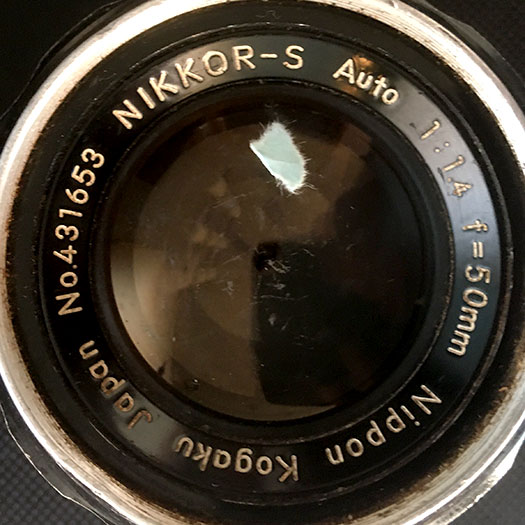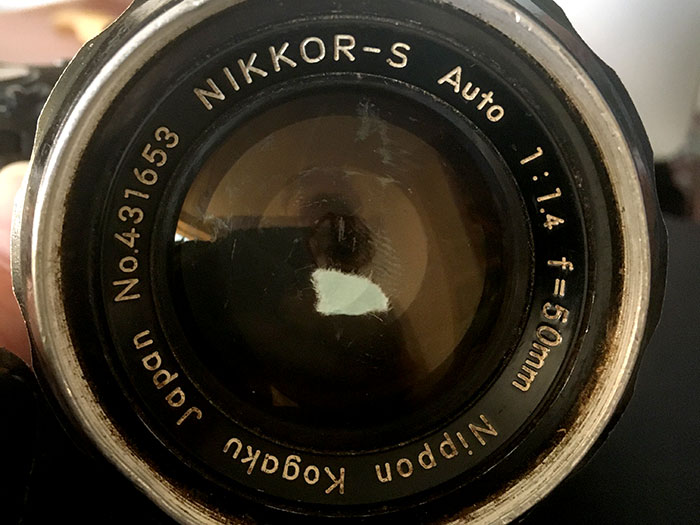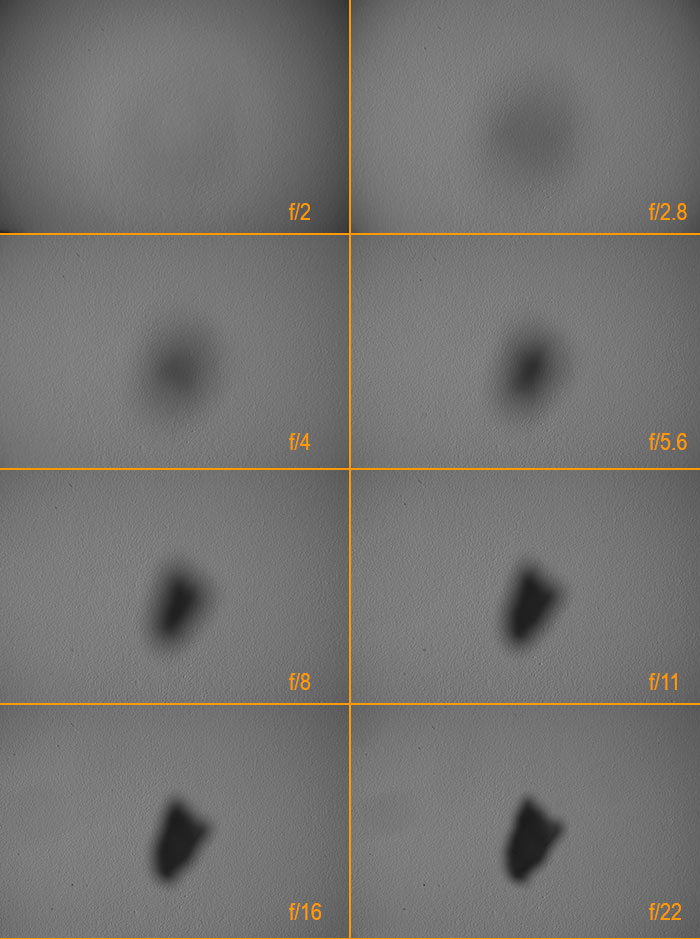Pekka Buttler, June-July 2020
[NOTE, 30.7.2020! I’ve been procrastinating with publishing this part for some time, because I remain somewhat unhappy with it, on account of that I am (somewhat) failing to explain optics in relation to dust/dirt in a way which would simultaneously not oversimplify the issue, but would nevertheless remain readable for all. As I cannot see a better way of explaining things (than what is below), not publishing the piece seems senseless. If and when I find a better approach, I will ruthlessly edit the article.]
Anyone who’s been active on a photography forum for any length of time, has certainly stumbled upon a concerned poster showing pictures of how dust-filled their lens is, and then asking what can be done about it. Typically, among those who answer the poster, there will be a lot of people recommending getting the lens cleaned, as well as a group which tries to convince the original poster, that they have very little to be worried about.
Should you find me participating in that discussion, you will most probably find me in the later group. In this article, I explain why that is. Incidentally, this article also explains why I have (in this series of articles) repeatedly said that fungus/scratches/separation coating loss most often has very little to no effect on pictures.
Now, in case you are asking “how can some people think dust is bad and should be cleaned, while others say it’s nothing to worry about…?” The reason is simply that many do not know enough about how lenses work. Moreover, this ignorance is not reserved only for amateurs, as I know many professional photographers who do not know either.
Before we go on, a mild warning is in order: This might –at times – get a tad technical. I’m not going to dazzle you with formulas, instead I will try to explain things verbally, and as simply as possible. Still, optics are not always easy to simplify, so if you read this and do not understand, don’t feel stupid. Thinking about this stuff just takes some time getting used to.
What lenses are, and aren’t; and why that might make a difference
First, some terminology: a photographic lens (a.k.a. objective) is the entire group of optics (lens elements) including diaphragm which define the optical characteristics of the lens. A lens element is a single piece of glass within a lens, which has the effect of bending light in some way. In many lenses, some lens elements are cemented together to act as one, and form a group.
Any singular lens element has a focal length, which is the distance from the middle of the lens element to the point at which rays converge (on in the case of a concave lens, the imaginary origin of the diverging rays).

The (slightly counterintuitive) aspect of lenses elements, is that the glass of the lens element does not actually bend light rays, but all the bending is done by the lens element surfaces. The amount of bending thus is basically dependant on only two factors, the angle at which light hits and the type of transition (air-glass, or glass-fluorite etc.). Don’t worry, I won’t befuddle you by discussing refractive indexes (a measurement of how strongly light is bent).
Also, most illustrations of how a lens works do not show how each air-glass interface bends light, and if they do, the visualisation typically shows either only a single light-point, shows only two paths or highlights some aberration. Any realistic visualisation would quickly go beyond what us mere mortals could comprehend.
The central point is that, when you start combining several lens elements of several types, some odd stuff starts happening. One basic principle is that the base characteristics (such as focal length) of any collection of lenses are described as if there was only one element. This leads to further counterintuitive aspects, for instance that the (at this stage) somewhat imaginary focal length of a lens may produce a focal length which in real terms would reside inside the lens itself. To circumvent these oddities, it would make more sense to not speak of focal lengths at all, but to instead speak of viewing angles, with respect to the intended sensor/film size (see some more about the topic here).
What is most befuddling is that lenses composed of several lens elements work in a somewhat unexpected fashion, that the final image (what appears on your sensor/film or optical viewfinder) is not the product of any single lens element, but is the sum total of all the lens elements in conjunction with the flange focal distance. It is an equation where each element must hold true.
Most importantly, light from each single point (in the vista you are photographing) hits the entire surface of your front lens element of your lens, is bent, hits a significant part of the back surface, heads straight for the next lens element and so on. This means that lenses first jumble together all the different light rays, only for them to exit the back lens element nicely separated. In practice, this means that if a portion of a lens element surface is covered by dust or debris, the rest of the lens element’s surface will be able to do a lot to compensate for it. This does not mean that dirt and debris can not be visible in the final image, but it is quite unlikely.
[Note! I suspect that many of the misconceptions on how lens elements work are based on that a) our paradigm of lenses are based on eyeglasses, magnifying glasses, etc. (i.e. one-element lenses), and b) that our paradigm is based on the (erroneous) conception that the film/sensor is equal to our eyes.
While there certainly are parallels (lens, pupil, retina and lens, diaphragm, sensor), the most important differences are 1) that the image we see is more dependent on out brain than it is based on our retinas; 2) Whenever we view any optical assembly (like when we look through a lens) we are adding one lens (the one in our eyeball) to the designed equation. Hence, what we see when looking through a lens is utterly different from what that lens produces onto a film or sensor.]
I think the best illustration of how lenses are able to compensate for dirt and debris is given through a somewhat extreme experiment:
“Visible” dirt ?
Naturally, the biggest worry both amateur and pro photographers have is that by not cleaning their lens, they will end up using excruciating hours in post-production, cleaning blotches and dots away from their money shots. I will try to assuage some of those fears, because the simple fact is that normal dirt and even minor debris inside the lens rarely manages to show up on the final image. This section will demonstrate and try to explain why that is. One of the lenses I am using in this experiment is a classic lens, which has seen a lot of action. I refer to this lens as the ‘warhorse’.
Firstly, even though you have a nice, round front lens element, not all of that element is used in forming the picture on the lens/sensor. In fact, a lot of the lens is simply there, because it is easier to manufacture the entire lens (and not only those parts which participate in forming the picture on the film/sensor)).

The position of the scrap of post-it above is such, that its lowermost edge barely appears on the sensor (at any apeture). Incidentally, this is why fungus around element edges or element separation around the edge of a lens element typically in no way show up in pictures.
Okay, you say, “What about when the blemishes are in the middle of the lens element, like those scratches you have on that lens?” Good question. The simple fact is that I’ve taken hundreds of pictures with that lens, an I’ve never been able to discern any artefacts (such as light or dark splotches) in a final picture that i could attribute to those scratches and blemishes.
So, let’s up the ante. Let’s put that post-it smack in the middle of the lens. Now, it must surely show?

And depending on your selected aperture, it either does or does not. The series of pictures below show the effect of that post-it (pictures of antique kitchen cabinet at close to minimum focusing distance).

From f/1.4 (top left) to f/16 (bottom right) in full-stop increments
The simple reason for why the post-it does not show in the first pictures (but starts being visible in the later pictures) is related to depth-of-field. “depth-of-field” or DOF is photo lingo for “depth of the field of sharpness” and describes the slice (of distance from sensor/film) which is reasonably sharp (this topic may be worth an article at a later date).
In the case of a 50 mm lens set to f/1.4, focused on 0,6 meters (MFD for this lens), mounted on a Sony a7R2, depth of field is less than three centimeters, which means that the lens manages to draw a reasonably sharp image (in the centre) only of objects which are (roughly) between 59 cm and 62 cm distant. With the post-it being at roughly 9 cm, it’s simply too far outside the sharp area to show.
Closing down the aperture significantly increases the depth-of-field, until at f/16, DOF reaches roughly 30 cm. As always, one third of the DOF is in front of the focusing distance, and the rest is behind, meaning the reasonably sharp slice of reality starts at 50 cm and goes all the way to 80 cm. The post-it is still waaay too close to be in focus, but now it is “close enough” to the sharp area to show up, but with heavily blurred edges.
In fact, the post-it shows in the picture simply because it is so large. At roughly 100 times the area of even the biggest of the blemishes on the lens surface, the post-it creates a clearly visible speck, whereas none of those scratches ever will. Period.
But wait. This does not mean that scratches or specks of dirt will never show up. Ceteris paribus (other things being equal), wider-angle lenses always produce a deeper depth-of-field. So if you understood what I mentioned above about the significance of depth-of-field, then you might already guess what I’m going to say next: The likelihood of dirt (or specks or scratches) to show up depends on the focal length of the lens (and the aperture used, etc.). After moving the post-it scrap to a significantly more wide-angle lens (in this case a 24 mm f/2 lens), I took another series of shots, this time of a painted concrete wall.

Now, not only is the post-it discernible from the even the widest aperture shots, its outlines also become significantly clearer. The change is further accentuated by the somewhat “darker” aperture range of this lens (f/2–f/22 instead of f/1.4–f/16). With ultra-wide lenses (20 mm and shorter), the risk of a larger speck of dust on the front element to show up is quite real.
Remember, however, that the post-it used in these experiments is both immensely larger than the ordinary speck of dust/other stuff which you might have to deal with regularly. Moreover, this post-it is relatively opaque.
The picture below shows a lens which actually has the remnants of a bug embedded in the optics, and – moreover – relatively close to the optical axis/centre of the lens. Even so, I have never taken a picture with that lens which would have shown that bug.

Other detrimental effects?
We’ve ascertained that normal-size specks of dust or debris in a lens are highly unlikely to show up on the final image. In fact, if you can see specks or dark blotches on your images, they almost certainly are due to dust on the sensor. But this does not mean, that a very dirty lens would not have a detrimental effect on your image quality.
In fact, the first set of images with a post-it covering the centre of the lens already give a hint (especially at f/4 or f/5.6) of the effect dust and debris have on image quality: In principle, every scratch on a lens surface, every speck of dust, and every bug in the lens does lower resolution and contrast. Hence, even when you have a hundred dust motes or scratches on your lens and even thought none of them show up in the final image, they will nevertheless be able to detrimentally effect contrast and sharpness. Whether that effect is noticeable (or real-world relevant) depends on how severely scratched/dirty your lens is. It is however safe to say that, ceteris paribus (other things being equal), a cleaner lens is always better.
Moreover, extreme amounts of dust may marginally lessen the amount of light which manages to pass through the lens (leading to longer shutter speeds), and when shooting against strong light sources, extreme amounts of scratches/dust (especially if the dust is reflective) could increase the internal reflections produced in a lens.
When is dust severe?
The real question is: when is some dust “too much dust”? When does my lens’ being dust-filled start to show up? Most importantly, when should I go and have it cleaned? This question is partially determined by a) the intended use of the lens, as well as b) where/how you intend to get the lens cleaned.
As you’ve noticed from the examples above, the effect of even a big piece of debris (such as the post-it) is least discernible when shooting wide open, so if your intended use of the lens includes a lot of wide-open shooting, the effect of dust is negligible. Especially in portrait use, dust is nothing to worry about (in the olden days, portraits were customarily shot through silk stockings or with a coating of vaseline added to the front lens, in order to de-emphasise skin texture). If, on the other hand you aim for maximum resolution, and are keen on having your lens draw the picture with as much detail as possible, the threshold for dust becoming ‘too much’ is naturally somewhat lower.
That said, when buying a lens, dust is (IMO) justification for a mild discount. Not so much because of the effect it has on the images, but because people believe it to have such an effect, thus lessening the value you can expect to recoup should you try to sell the lens.
Dust-removal
Again, I recommend you test the lens and try to ascertain signs of dust/debris leading to lowered definition, before embarking on having the lens cleaned. While lens cleaning is not a complicated job for a professional who has the right tools, it still is precision work, and it takes some time. In other words, it’s not gratis.
And while you might think that the equation is significantly different when you intend to clean the lens yourself (It being gratis, you might think the threshold is lower), think again. While the pro will (if they’re worth their salt) return your lens in squeaky clean condition, You will in all likelihood not achieve nearly the same level of result. In fact, you might easily make things worse (and this even without accidentally breaking anything).
The problem with trying to remove dust from within a lens is, that the lens typically is not as dust-ridden as it would seem. When inspecting a lens for dust using a flashlight, you typically see all the dust extremely clearly. On the other hand (unless your office/household has a lot of horizontal glass surfaces) you have very little idea of how dusty your office/household is. Your lens might seem very dusty/dirty compared to the ambient (while in fact being significantly cleaner). When re-inspecting the lens (with a flashlight) after having cleaned the lens, there’s a good chance of you be disappointed with the result.
Therefore, if you intend to open a lens (whether in order to clean it or otherwise repair it), you should do it in the cleanest space you have, clean and de-dust your working surfaces, select clean clothing which preferably is not a source of more dust, and – if you can – have an air-purifier running for a couple of hours before opening up the lens.
Read more:
Previous article: Part VI: Surface Defects
Next article: Part VIII: Miscellaneous Defects